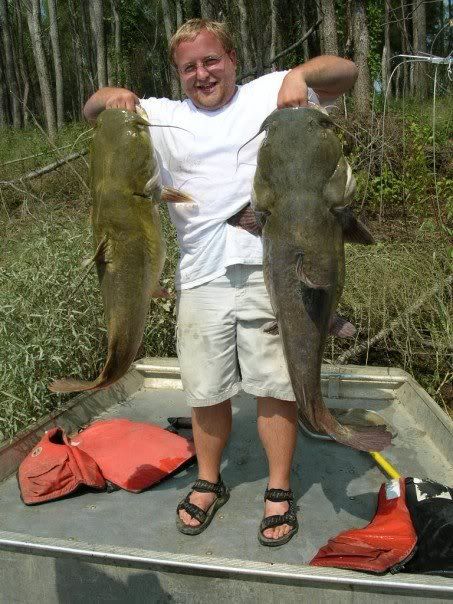I'm not convinced that flatheads are the fish eating machines that many people believe them to be. Sure they get big (really big) and a 50 lber could eat a lot of fish, but a few smallish ones (5-20 lbs) can't clean out a pond the way people think they will.
The thought that one or two 5 lbers could clean out a pond is pretty common in my experience. If a one acre fertilized, unfed, unaerated pond holds about 300 lbs of forage I don't see how 10 lbs of predators could eat all that in a few months or even a year. I don't know what the food conversion rate on a flathead is, but I will assume that it is near the 10:1 that is commonly used for LMB. If those two 5 lb fish ate all the forage fish in a year (assuming the forage fish didn't grow or reproduce, just to vastly oversimplify this) each flathead would gain 15 lbs. (300 forage/2 fish = 150 lbs converted at 10:1=15 lbs). A flathead growing from 5 lbs to 20 lbs seems pretty unbelievable.
That being said, I think flatheads have a place in pond management. The fact that they do get big and 5 lbers are reasonably easy to get a hold of from wild sources; relatively few of them could be stocked to quickly add a top end predator to an unbalanced pond.
I don't know the price of 5lb bass, but I don't think many are available for sale and they could be near the end of their life anyway (especially up north). So a common option that many people select is to stock a bunch of the largest LMB they can find, which is usually around 6-8 inches. So now their pond has a bunch of stunted 5 inch bluegeills that their new LMB can't eat for 1-2 years. So they have to wait for the bass to grow and hope they don't get eaten by other bass, herons, etc before they can even begin to do their job.
My thought with the Flatheads is to stock them and they immediately go to work.
This is all theory, I don't claim to be an expert. I do know that I liked the idea enough to stock 2 5 lb. flatheads into my dad's 0.9 acre pond May of 2008.
The bluegills in the pond were consistently running 5-6" even after 8 years of catch and release only bass fishing, as well as sporadic bluegill removal. The pond also contained a healthy population of unwanted 8" bullheads that washed into the pond when an upstream neighbors dam blew out. Bullheads happen to be high on the list of the flathead's prefered foods. And the flatheads tend to spend more time on the bottom as do the bullheads. This seemed like a good situation to try out the flatheads.
The hope was that they would preferentially eat the bullheads followed by the abundant small bluegills and leave the bass for last. The plan was to remove the flatheads upon seeing a vast improvement in the size of the bluegills OR upon noticing quickly decreasing catch rates of LMB.
So far they haven't made a noticeable impact on the bluegill or the LMB as far as we can tell from fishing. Not sure about the bullheads as we don't target them. I can conclude this though: the addition of two 5 lb flatheads to a 1 acre pond didn't lead to the complete disappearance of all the other fish within the first year and a half.
and for fun, a flathead pic:

